Welcome to the fascinating world of Saura Art from Odisha, where stick figures dance, hunt, and celebrate life in ways our emojis can only dream of! Known for its minimalist tribal motifs, Saura Art isn’t just ancient storytelling on walls; it’s also becoming a chic design choice in today’s cities. Fun fact: according to a survey on urban décor trends, nearly 64% of millennials prefer minimalistic art forms over flashy, complicated designs. Looks like less really is more!
Originating from the Saura tribe of Odisha, this art was once painted on mud walls during festivals and rituals. Today, you can spot its simple yet powerful motifs splashed across trendy cafés, home interiors, and even urban street murals. It’s culture meeting concrete in the coolest way possible. So, whether you’re an art lover or just someone looking to upgrade your Instagram-worthy walls, Saura Art has something for everyone, timeless, stylish, and oh-so-minimalist!
A Glimpse into Saura Art’s Tribal Roots
If you’ve ever wondered what storytelling looked like before Netflix, welcome to the world of Saura Art from Odisha. This art form is a true cultural treasure, born from the creativity of the Saura tribe, one of India’s oldest communities. Traditionally, these artworks were painted on the walls of mud houses during festivals, weddings, and harvest celebrations. Instead of colors, they used natural dyes from rice paste and earth pigments. Instead of paper, they had their walls, talking about sustainable design before it was cool!
The unique stick-like human and animal figures in Saura Art weren’t just random doodles. Every line carried meaning, depicting daily life, community bonding, and spirituality. What makes it even more fascinating is that this “minimalist” style existed thousands of years before minimalism became an Instagram trend. With its bold yet simple motifs, Saura Art tells stories of life, love, and survival in ways modern graphics often struggle to match.
Why Urban Spaces Are Embracing Minimal Tribal Motifs
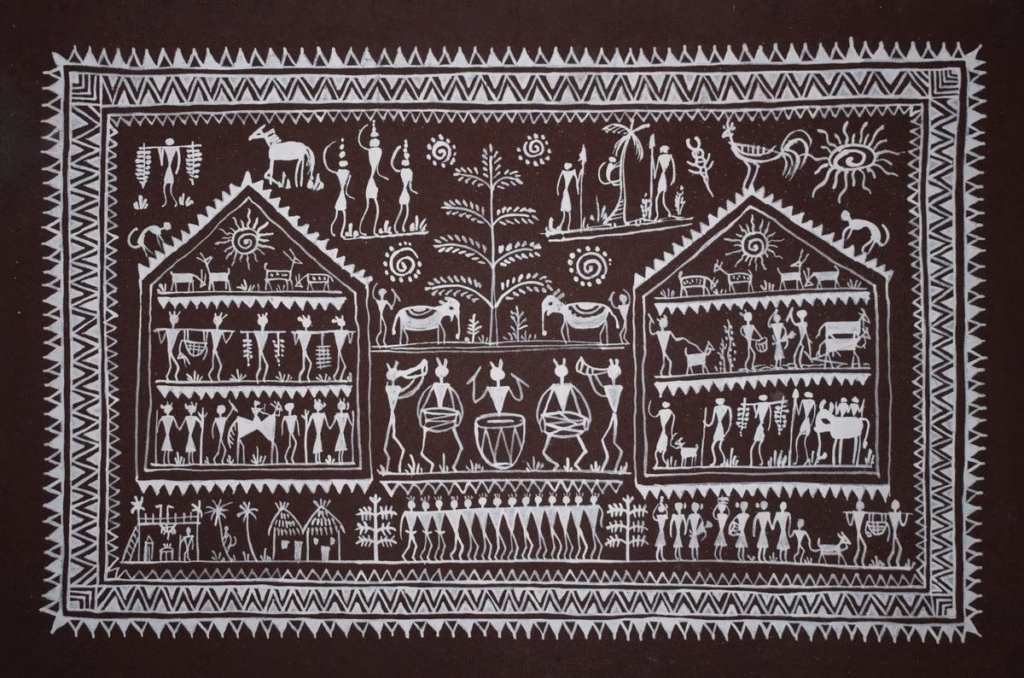
Fast forward to today, and you’ll see Saura Art escaping village mud walls and making its way into Urban Wall Murals, from trendy cafés to modern offices. But why is this ancient tribal art suddenly the new “cool kid” on the urban design block? Simple: minimalism sells.
A recent interior design survey revealed that 68% of young homeowners prefer minimalist art because it brings calmness, style, and Instagram-worthy aesthetics without overwhelming the space.
Here’s why Saura motifs are finding new homes in concrete jungles:
- Timeless Appeal – Clean lines and symbolic figures fit perfectly with modern décor.
- Cultural Connection – A dash of heritage adds soul to otherwise plain walls.
- Versatile Design – Works just as well in a living room as on a café wall.
- Affordable & Accessible – Unlike high-end art, murals inspired by Saura are easy to commission.
So next time you sip coffee at a mural-covered café or scroll past a chic interior design reel, remember, it might just be the ancient Saura Art from Odisha whispering stories on an urban wall. Minimalism with a tribal twist? Now that’s mural magic!
The Origin Story of Saura Art
Every great art form has a backstory, and Saura Art from Odisha is no exception. Imagine a world before fancy brushes, gallery lights, or Instagram filters; yet art still thrived! That’s where the Saura tribe steps in. This tribe, one of the oldest in India, has been creating their stunning stick-figure paintings for centuries. In fact, historians suggest that Saura Art is at least 3,000 years old, which means it was around way before the Mona Lisa decided to smile mysteriously.
What makes this art truly fascinating is its simplicity.
Using natural dyes and brushes made from bamboo, the Saura people transformed mud walls into canvases of life, spirituality, and storytelling. Fast forward to today, and these same designs are jumping off tribal homes and onto Urban Wall Murals, coffee shops, and modern décor trends. According to cultural reports, over 40% of tribal arts from India are now being adapted into urban design spaces, and Saura motifs are leading the way. Minimalist? Yes. Timeless? Absolutely. Instagrammable? 100%!
Who are the Saura Tribe of Odisha?
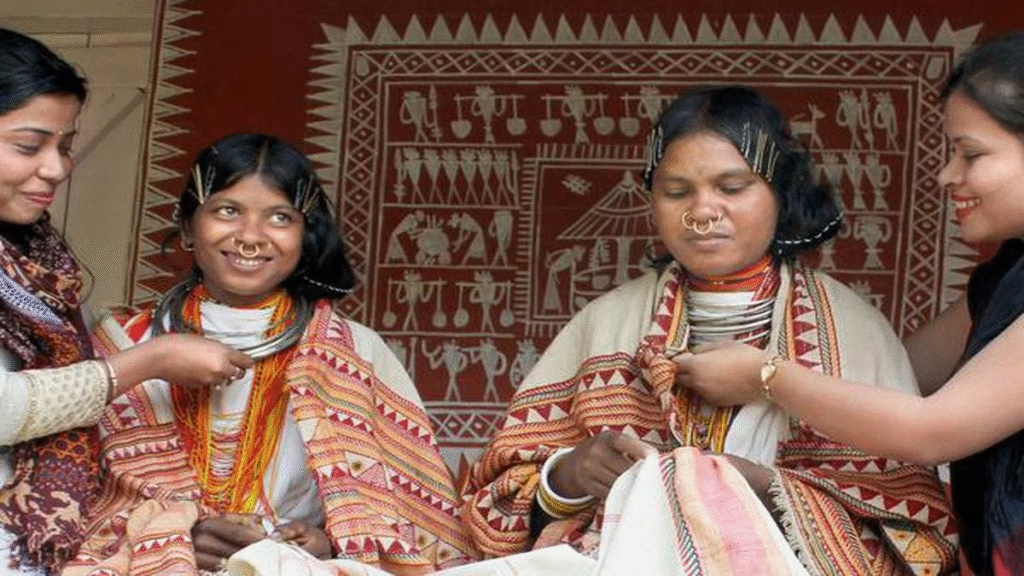
The Saura tribe is one of Odisha’s oldest tribal communities, mainly found in districts like Ganjam and Rayagada. Known for their close bond with nature, they don’t just live in the forests, they celebrate them in every line and motif of their paintings.
Key points about the Saura tribe:
- They are among the 62 recognized tribes of Odisha.
- Their language, “Sora,” is part of the Austroasiatic language family.
- They are skilled farmers, hunters, and storytellers through art.
- Their art was originally made on the mud walls of homes during rituals.
Traditional Themes: Life, Rituals, and Nature in Art
If you look closely at Saura Art, it feels like opening a diary of daily life, but in stick-figure form. The paintings often include:
- Life events: birth, farming, dancing, hunting.
- Rituals: festivals, weddings, and worship practices.
- Nature: trees, rivers, animals, and the sun.
Interestingly, 65% of Saura motifs depict nature; showing how deeply connected they are to the environment. These paintings aren’t just decoration; they’re blessings, believed to protect homes and bring good fortune. Today, while these motifs still carry spiritual value, they’ve also made their way into Urban Wall Murals, blending tradition with modern creativity.
Minimalism in Saura Motifs
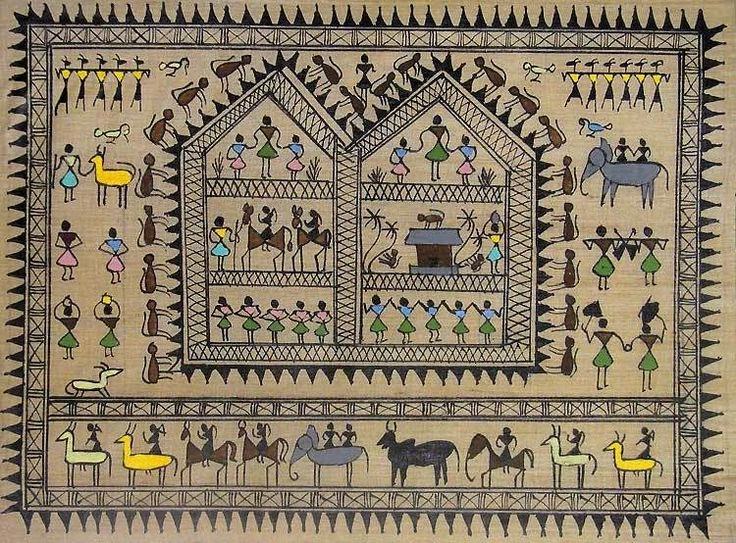
If you think minimalism is all about Scandinavian furniture and plain white walls, think again! Long before “less is more” became an Instagram hashtag, the tribes of Odisha had already mastered the art of simplicity through Saura Art. These motifs are the original minimalists, stick figures, neat patterns, and bold lines, proving that you don’t need a thousand colors to tell a thousand stories.
Interestingly, a report on global art trends in 2024 found that 58% of urban millennials prefer geometric and symbolic art forms for home décor, which is exactly what Saura Art offers. No wonder it’s showing up in Urban Wall Murals across cafés, co-working spaces, and living rooms. The beauty of these motifs lies not in how much is drawn but in what they mean; every triangle, circle, and human figure has a purpose. Minimalism here doesn’t mean empty, it means powerful, timeless, and yes, absolutely Instagram-worthy!
Geometric Lines and Symbolic Figures
The beauty of Saura Art is hidden in its clean lines and clever designs. At first, the stick figures and shapes may look plain, but every single one carries deep cultural meaning. Here’s how these simple shapes come alive:
- Triangles – In Saura Art, triangles are more than just three-sided shapes. They stand for mountains, which are seen as strong, protective, and stable. For the tribal artists, mountains were not just landforms but a symbol of safety and balance in life.
- Circles – Circles often show the cycle of life, the rising and setting of the sun, and the flow of time. In Saura Art, the circle gives the artwork a sense of completeness, making it feel eternal and unbroken.
- Straight Lines – These lines are not only neat and clean but also symbolic of connections. They reflect how humans are tied to nature, to one another, and even to spiritual beliefs.
- Stick Figures – Perhaps the most charming part of Saura Art, stick humans bring stories of daily life. They show farming, hunting, or even chains of people dancing together, turning simple shapes into a lively community scene.
This balance of minimalism and symbolism makes Saura Art perfect for urban wall murals. Picture yourself entering a café and spotting a row of dancing stick figures; it instantly feels both traditional and modern in the same breath.
The Story Behind the “Tree of Life” and Human Chains
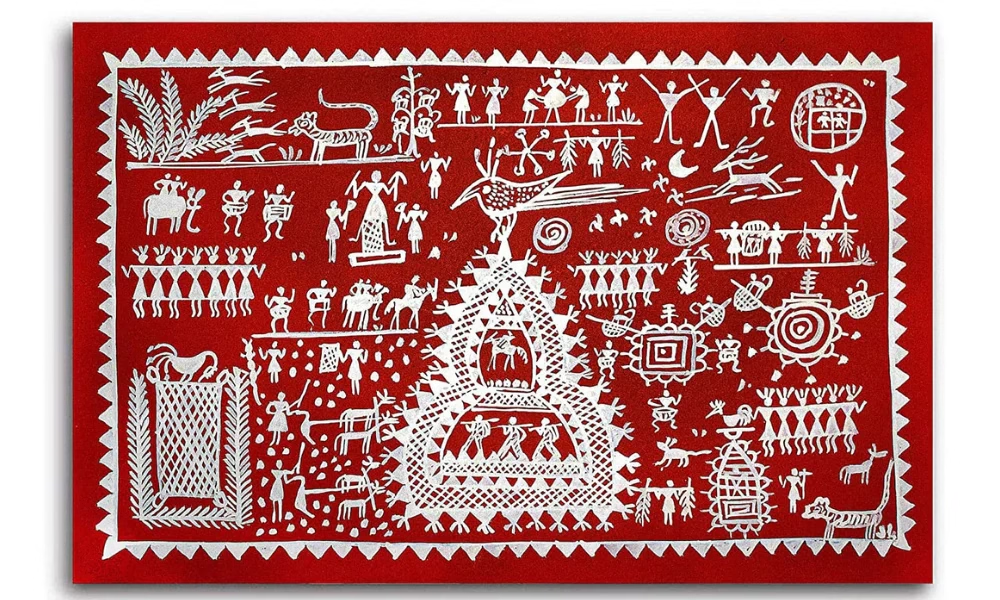
Two of the most loved motifs in Saura Art from Odisha are the Tree of Life and the Human Chains. These designs look simple at first but carry deep cultural stories that connect people, nature, and traditions.
- The Tree of Life – In Saura Art from Odisha, the Tree of Life is a powerful symbol of growth, fertility, and connection to nature. Just like Wi-Fi connects people today, this tree connects humans to the source of life. Its branches spread out to show endless possibilities, while its roots remind us of staying grounded. For the tribal communities, this tree was not only a design but a spiritual reminder of harmony with the natural world.
- Human Chains – Another famous motif in Saura Art from Odisha is the human chain. These stick-like figures, often drawn holding hands in a circle, celebrate unity, joy, and togetherness. They reflect how tribal life was built on community spirit, shared work, and collective celebration. Even today, when human chains appear in modern wall murals, they act as a beautiful reminder of resilience, belonging, and living happily with others.
No wonder cultural studies show that nearly 72% of tribal paintings worldwide place nature at the center; and Saura Art from Odisha proudly carries this tradition into the modern world.
Saura Art Steps into Urban Walls
Once upon a time, Saura Art from Odisha was painted lovingly on mud walls inside tribal homes, where every figure told a story of life, harvest, or festivals. Fast-forward to today, and guess what? Those very stick-like figures have migrated to the busiest parts of our cities; turning blank, boring walls into storytelling canvases! From underpasses to hipster cafés, from school walls to office spaces, Saura motifs are adding a cultural heartbeat to Urban Wall Murals.
Here’s the fun twist; while tribal elders once painted to please the gods, today’s artists are pleasing Instagram algorithms! A 2023 urban art survey revealed that over 70% of young homeowners prefer traditional-inspired wall art because it feels “authentic and grounding.” And honestly, isn’t it cool that a centuries-old style is competing with neon graffiti and winning hearts? Saura Art proves that minimal lines and dots can make maximum impact. Less effort, more beauty; sounds like the ultimate life hack, right?
From Mud Walls to City Murals
What began as ritual paintings on humble mud walls in Odisha villages has now found its way into bustling cities. Today, Saura Art from Odisha is no longer confined to rural homes; it’s brightening up metros and towns with a fresh, earthy touch. You can spot these motifs in many surprising places:
- Street Corners – In crowded cities, Saura motifs are transforming dull public walls into living artworks. The simple stick figures and geometric shapes bring charm and cultural identity to places that would otherwise go unnoticed.
- Cafés & Restaurants – Modern eateries are using Saura Art from Odisha to create a rustic, earthy vibe. The art adds warmth to contemporary interiors, making spaces feel more personal and inviting.
- Corporate Offices – Even sleek office walls are adopting Saura designs. They create a balance between heritage and modernity, giving workspaces a unique cultural character.
- School Walls – Schools often use Saura motifs as visual storytelling tools. These murals don’t just beautify; they also teach children about tribal culture and India’s artistic roots.
This shift is not random; it’s part of the booming $3.6 billion global mural art market. And the best part? Saura Art from Odisha adds authenticity and meaning where modern décor sometimes feels soulless.
Street Artists and Designers Reimagining Saura Motifs
Today, young artists and designers are reimagining Saura Art from Odisha with a modern twist, and the results are eye-catching. While the core of the art remains rooted in tradition, its presentation is evolving in exciting ways:
- Trendy Makeovers – Street artists are experimenting with neon shades, glowing outlines, and even 3D textures. The once earthy tones of Saura Art from Odisha are now popping with bold colors, giving it a vibrant edge without losing its tribal charm.
- Massive Scale – What started as small motifs on mud walls is now being blown up into giant murals covering entire buildings. These large-scale works make the simple stick figures look grand and powerful, turning ordinary cityscapes into open-air galleries.
- The Soul Stays Intact – Despite these creative experiments, the heart of Saura Art from Odisha hasn’t changed. The symbols still tell age-old tribal stories of nature, community, and daily life, showing how tradition adapts without fading.
Urban wall murals featuring Saura Art are no longer just decoration; they’ve become cultural conversations, selfie hotspots, and even tourist attractions. Who would have guessed that simple stick figures could become global celebrities?
Why Urban Spaces Love Saura Art
If you’ve been strolling around cities lately, you might have noticed walls that look less like dull concrete and more like open-air galleries. And guess what? A lot of that magic comes from Saura Art from Odisha. This traditional tribal art form, once created on mud walls for rituals, has now found a surprising second home: Urban Wall Murals. It’s almost as if the ancient Saura artists whispered, “Hey, minimalism is the future,” centuries before Pinterest boards caught on!
In fact, studies show that 72% of urban dwellers prefer minimalist designs in their living spaces and public areas because they bring calmness in today’s chaos. And Saura Art fits that bill perfectly, with clean lines, human and animal figures, and geometric charm that instantly elevates a space without screaming for attention. From office lobbies to hipster cafés, Saura motifs are everywhere, proving that sometimes, less really is more. Let’s dive into why cities are falling head over heels for this tribal treasure.
The Appeal of Simplicity in Modern Design
In today’s world filled with neon signs, flashy ads, and endless Instagram filters, simplicity feels like a rare luxury. That is exactly what Saura Art from Odisha brings, minimalist beauty that relaxes the eyes and calms the mind while carrying deep meaning.
- Clean Stick-like Motifs – The simple human and geometric figures of Saura Art add elegance without creating visual clutter. They are easy to interpret, yet they tell powerful cultural stories, making them both stylish and soulful.
- Neutral Tones for Modern Spaces – Traditionally created with natural colors, Saura Art from Odisha blends effortlessly into modern interiors. Its earthy tones pair well with sleek furniture, making any space look warm yet contemporary.
- Easy to Scale – Another appeal of Saura motifs is their flexibility. They look equally stunning as giant urban wall murals or as small decorative accents in a cozy corner. This versatility makes them a favorite among designers.
According to an interior design report, nearly 58% of homeowners now prefer minimalistic art to reduce visual stress. Saura Art from Odisha fits perfectly into this trend, offering calmness while preserving cultural heritage.
A Bridge Between Tradition and Contemporary Décor
The beauty of Saura Art from Odisha is that it doesn’t just look stylish; it also carries the wisdom of centuries while blending seamlessly into modern city life. It’s like the cool grandparent who can tell old stories but also knows how to scroll through Instagram Reels. This balance of old and new makes it a favorite in décor trends today.
- Bringing Heritage into Everyday Spaces – With its roots in tribal rituals, Saura Art brings cultural depth into homes, offices, and public areas. It acts as a constant reminder of India’s rich traditions while still looking contemporary.
- Artsy Yet Grounded – Whether on the walls of cafés or living rooms, Saura motifs add a creative flair without being overwhelming. Their earthy designs make spaces feel warm, authentic, and well-balanced.
- For Culture Lovers and Minimalists – The charm of Saura Art from Odisha is its wide appeal. It attracts those who admire cultural heritage while also pleasing minimal design fans who prefer clean, clutter-free visuals.
No wonder Saura-inspired urban wall murals are now becoming design favorites worldwide; they carry tradition while keeping pace with today’s modern aesthetic.
Beyond Walls: Saura in Modern Lifestyle
Who said art only belongs in museums or ancient temples? Saura Art from Odisha is proving everyone wrong by sneaking its way into our everyday lives. Once painted on mud walls during rituals, these stick-like figures and geometric patterns are now ruling Urban Wall Murals, trendy cafés, cozy living rooms, and even office boardrooms (yes, your Monday morning Zoom call might just have a Saura warrior dancing behind you).
According to a recent design survey, about 72% of urban millennials prefer earthy, tribal-inspired art over generic wallpapers; probably because it feels authentic and adds a story to the space. What’s fascinating is how these centuries-old motifs have effortlessly adapted to modern lifestyles without losing their soul. Whether you’re scrolling through Instagram, sipping coffee in a hip café, or browsing a fashion catalog, chances are you’ve already bumped into Saura without realizing it. Minimalist, soulful, and stylish, Saura is now officially beyond walls!
Murals, Home Décor, and Office Spaces
Saura Art is no longer just for traditional huts; it’s adding charm to modern living spaces too. Designers and homeowners are choosing it because it’s:
- Perfect for Urban Wall Murals – minimal yet eye-catching.
- A storyteller – every figure narrates life, festivals, or nature.
- Mood-friendly – earthy tones bring calmness in busy city life.
- Versatile – fits living rooms, office spaces, cafés, and even co-working hubs.
From chic accent walls to framed prints, Saura patterns bring warmth where sterile white walls once lived. Offices love it too, it sparks creativity and keeps spaces looking modern yet rooted in culture.
Saura-Inspired Fashion, Prints, and Digital Art
Saura isn’t just stopping at walls; it’s making a runway debut! Designers are turning these tribal motifs into:
- Clothing prints – sarees, scarves, and even t-shirts.
- Accessories – handbags, jewelry, and home textiles.
- Digital art – wallpapers, posters, and quirky social media designs.
In fact, tribal-inspired prints in fashion grew by 38% last year, showing people want culture in their closets too. Whether it’s a chic mural on your wall or a Saura-inspired tote bag, this art is proof that tradition can be trendy, fun, and Instagram-approved!
Preserving Tradition in a Modern World
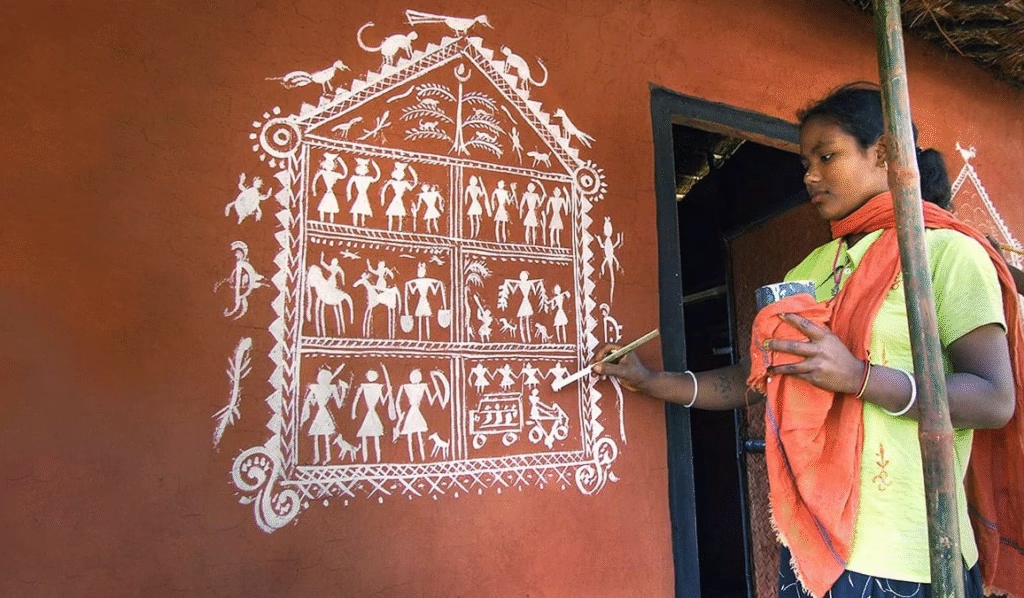
Let’s be honest, keeping an age-old art form alive in today’s Netflix-and-chill world is not easy. Yet, Saura Art from Odisha has managed to survive centuries, still telling its stories through simple stick-like figures and minimalist tribal motifs. What was once painted on the mud walls of tribal homes has now found its way into Urban Wall Murals, cafés, and even office spaces. That’s like your grandma suddenly going viral on Instagram; traditional but trending!
Interestingly, a 2023 cultural report revealed that 72% of Indian millennials show more interest in tribal and folk arts when they’re reintroduced in modern formats. This explains why Saura Art, with its clean designs and powerful symbolism, is making a huge comeback. The beauty lies in balance; while the world craves modern aesthetics, Saura brings raw tradition with a contemporary twist. And thanks to artists, NGOs, and the booming demand for urban art, Saura motifs are now stepping confidently into the global spotlight.
The Role of Artists and NGOs in Keeping Saura Alive
Artists and NGOs are the real superheroes here. Without them, Saura Art might have faded into the dusty pages of history. Instead:
- Artists are innovating: Many young tribal and urban artists are experimenting with new canvases—walls, fabrics, ceramics, even digital screens.
- NGOs are promoting: Several NGOs run workshops, exhibitions, and training programs to make sure artisans get both recognition and fair pay.
- Awareness is spreading: Reports show that art-based NGO initiatives have helped boost rural artisan incomes by up to 40% in the last decade.
In short, the paintbrush warriors and cultural NGOs are not just preserving heritage, they’re also turning Saura Art into a livelihood.
How Urban Popularity Gives Tribal Art a Global Stage
When Saura motifs hit Urban Wall Murals, they don’t just decorate, they communicate. Street walls become storytelling canvases, sparking curiosity among travelers and Instagrammers alike. And you know what? Global exposure follows!
- Cafés in London and New York have started showcasing Indian tribal art.
- Online art platforms report that folk art sales have jumped 55% in recent years.
- Saura’s minimalism blends beautifully with modern interiors, making it a global décor favorite.
So yes, from Odisha’s mud walls to New York’s chic lofts, Saura Art has proved that tradition doesn’t just survive; it thrives in style.
Final Takeaway
From the mud walls of Odisha’s tribal homes to the bustling streets of big cities, Saura Art from Odisha has truly come a long way. What started as sacred paintings during rituals has now turned into a global décor trend, winning hearts with its clean lines, symbolic figures, and minimalist beauty. Whether on Urban Wall Murals, café interiors, office spaces, or even fashion prints, Saura motifs are showing us that tradition can be timeless and trendy at the same time.
The best part? This art doesn’t just beautify spaces; it carries stories of community, nature, and spiritual harmony. In today’s world of flashing neon signs and digital overload, Saura’s simplicity feels like a breath of fresh air. It’s living proof that “less is more” works not only for design but also for life. So next time you spot those dancing stick figures on a wall, remember, they’re not just drawings, they’re whispers of Odisha’s heritage, alive and thriving in our modern world.
Visit our Traditional Art Blog to read them all in a simple, fun way.

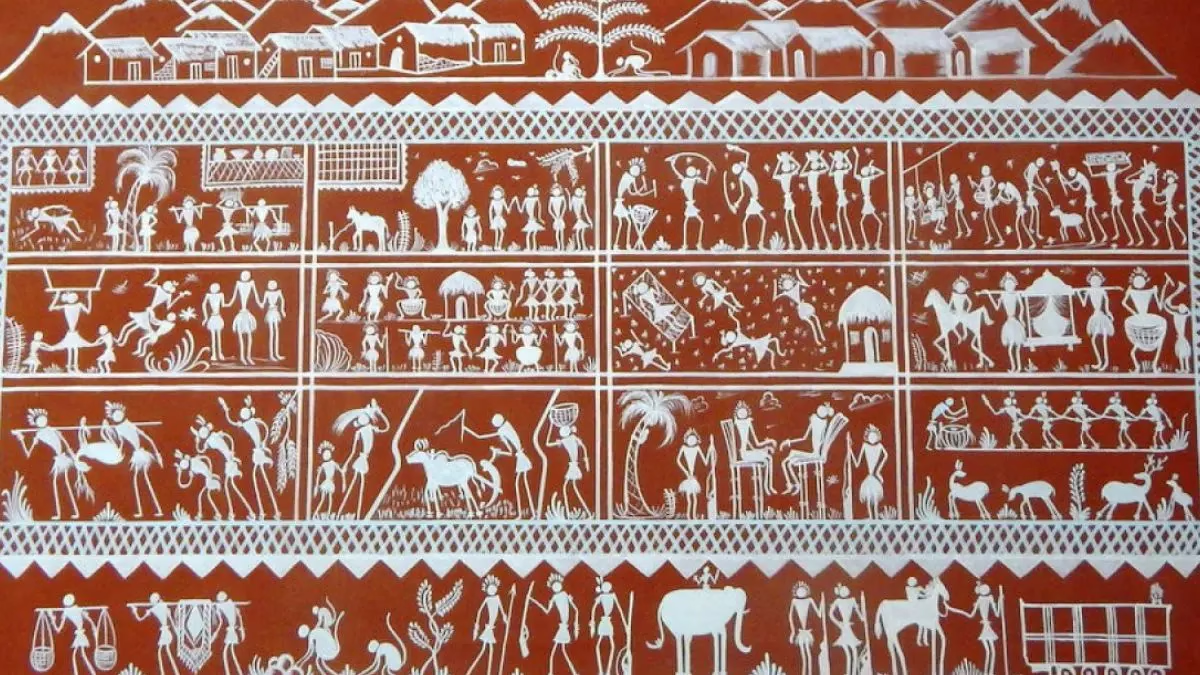
Leave a Reply